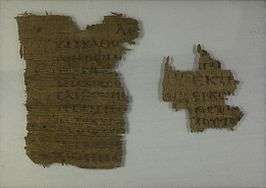Papyrus 36
Papyrus 36 (in de nummering volgens Gregory-Aland) of 36, is een oude kopie van het Griekse Nieuwe Testament. Het handschrift is geschreven op papyrus en bevat het Evangelie volgens Johannes 3:14-18; 31-32;.34-35.[1] Het handschrift is onderzocht door Pistelli, Carlini, en Horsley. Het bevindt zich in Biblioteca Medicea Laurenziana; Florence.
Papyrus 36
| ||
 | ||
| Symbool | 36 | |
| Bijbeltekst | Joh. 3:14-18; 31-32;.34-35. | |
| Datering | zesde euw | |
| Vindplaats | Egypte | |
| Huidige locatie | Biblioteca Medicea Laurenziana; Florence. | |
| Publicatie | E. Pistelli, PGLSI I (1912), pp. 5-6 | |
| Teksttype | Eclectische tekst | |
| Categorie | III | |
Op grond van het schrifttype wordt het manuscript gedateerd in de zesde eeuw. De Griekse tekst van deze codex is eclectisch. Aland plaatst het in Categorie III.[1]
Zie ook
Noten
- Dit artikel of een eerdere versie ervan is een (gedeeltelijke) vertaling van het artikel Papyrus 36 op de Engelstalige Wikipedia, dat onder de licentie Creative Commons Naamsvermelding/Gelijk delen valt. Zie de bewerkingsgeschiedenis aldaar.
- Kurt Aland, en Barbara Aland, The Text of the New Testament: An Introduction to the Critical Editions and to the Theory and Practice of Modern Textual Criticism, trans. Erroll F. Rhodes, William B. Eerdmans Publishing Company, Grand Rapids, Michigan, 1995, p. 98.
Literatuur
- E. Pistelli, Papiri greci e latini della Società Italiana I (Florence 1912), pp. 5–6.
- A. Carlini, Riesame di due frammenti fiorentini del vangelo di Giovanni, AP 22/23 (1974), pp. 219–222.
- A. Carlini, Papiri litterari greci 28 (Pisa, 1978), pp. 193–199.
- G. H. R. Horsley, Scribal Carelessness in P36?, in: New Documents Illustrating Early Christianity, 3 (Macquarie University, 1983), pp. 100–101.
This article is issued from
Wikipedia.
The text is licensed under Creative
Commons - Attribution - Sharealike.
Additional terms may apply for the media files.